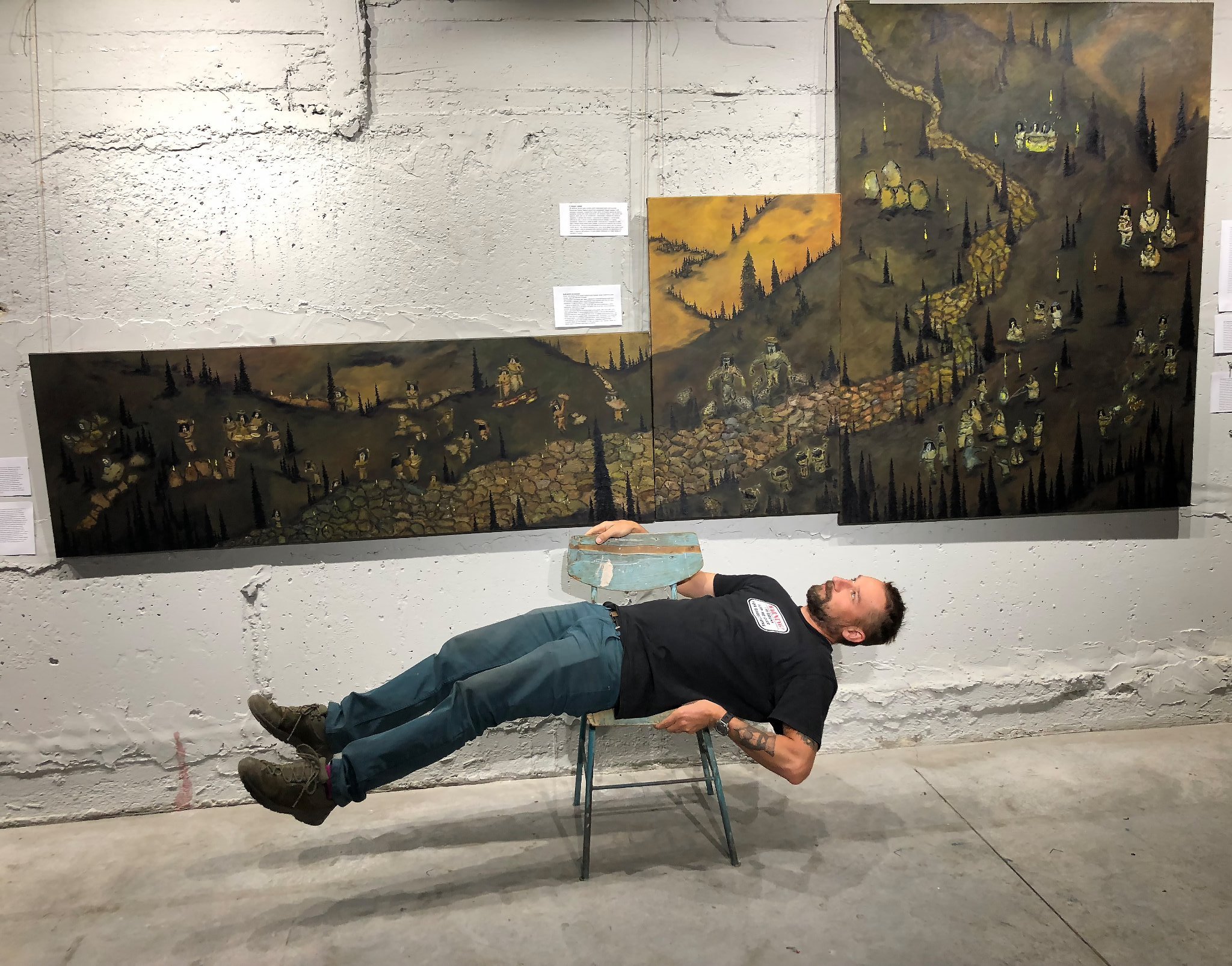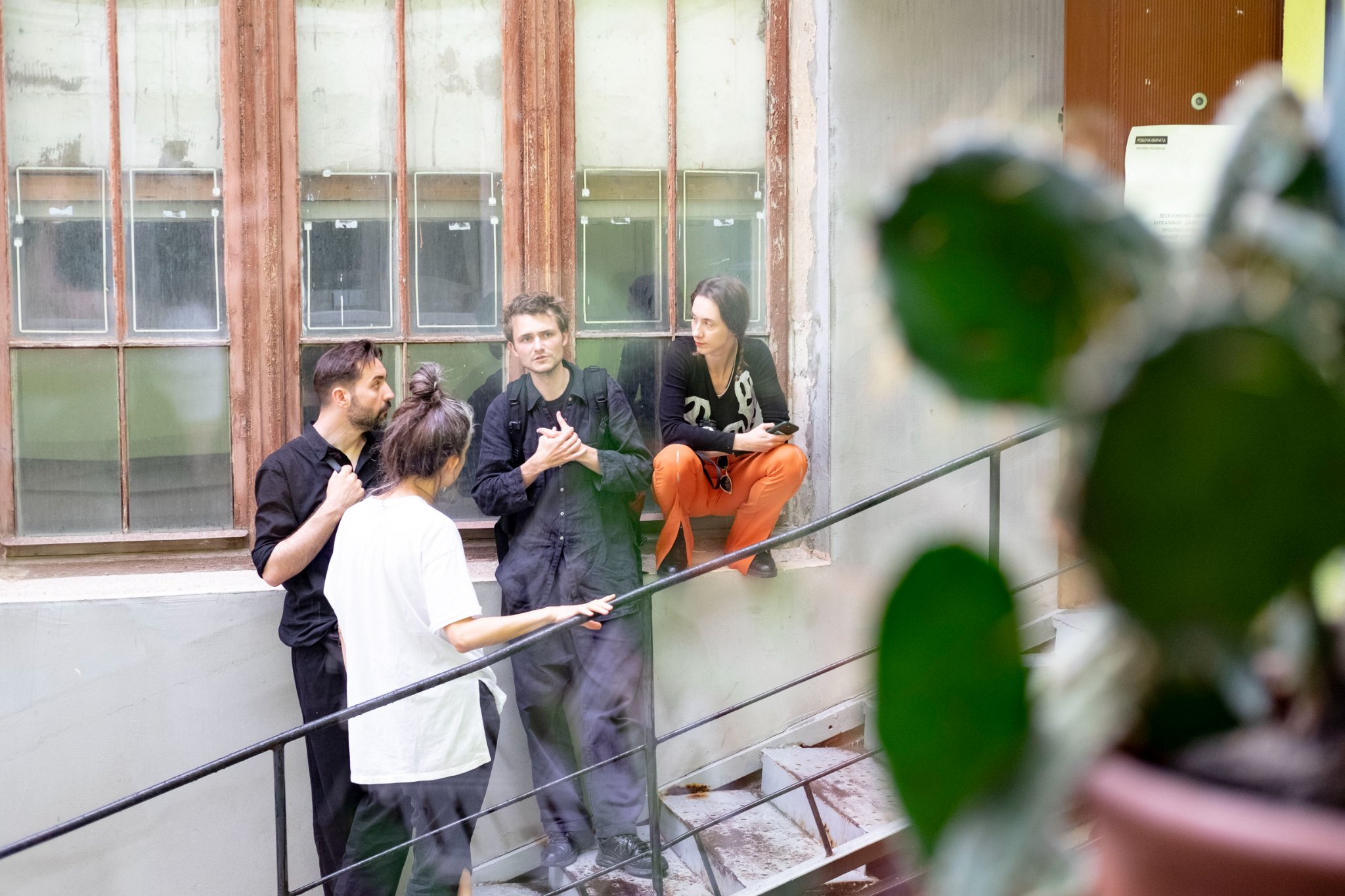
Marianna Hlynska, an artist from Ivano-Frankivsk, is a photographer, videographer, and occasional performer. Born in Kosiv, she received her education in the USA and chose Ivano-Frankivsk as a place for her creative work. Having not found a suitable gallery for her solo exhibition in the city, Marianna once decided to turn her apartment on Nyzova Street into an art space.
In recent months, Marianna has been at a residency program in Germany, where she participates in exhibitions and works on her own projects. We talked about her creative work, the city, and what an artist can do in wartime.
When did you realize that art is your thing?
I guess it was after my first academic year [at the faculty of Romano-Germanic philology] when I realized that I was missing something. I began to look for other opportunities and could not find anything for a long time. Once I enrolled in courses of cutting and sewing, but it was not it. However, when I came there, I saw an announcement about photo and video courses on the classroom door. At that time, they were conducted by Yulian Yakovyna. We met. He said that we would watch films and analyze them, but we would start with photography. The building was being renovated, so the courses were supposed to start in a few months. Since I was very interested, Mr Yakovyna and I met from time to time. We started with photography.
I found an old German camera with a Zeiss lens at home, bought the film and started photographing in different genres. I brought printed photos and we analyzed them, studied composition, color, and framing. It was back then when I started photographing people for the first time and realized that staged shots were my thing. My interest in photography grew more and more.
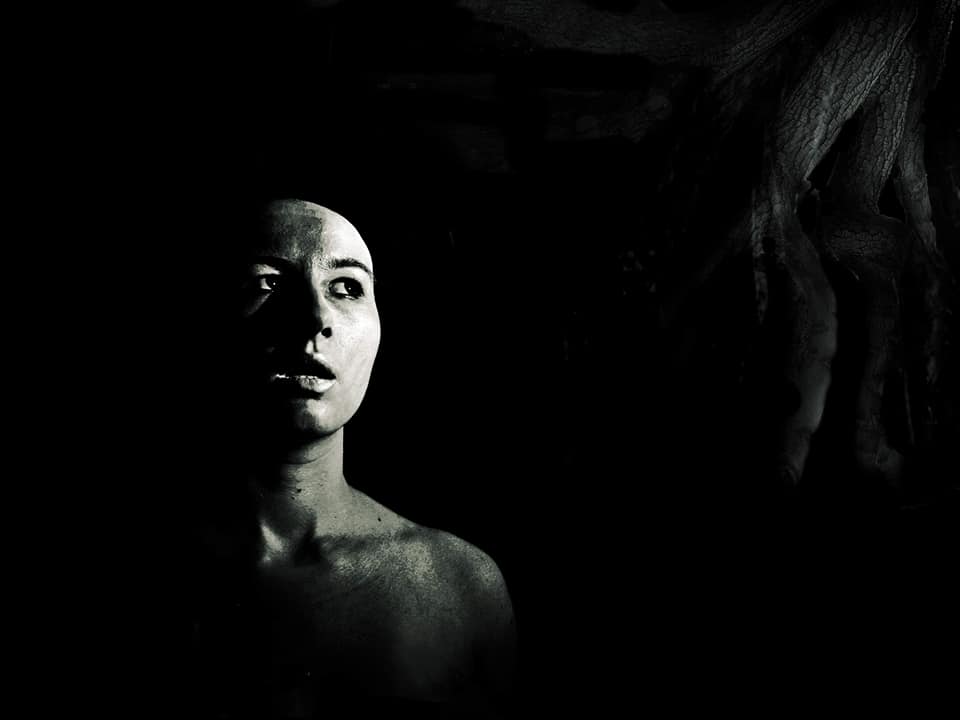
Self-portrait. Marianna Hlynska
What are photo and video arts for you?
I used to attend an art school, but unfortunately, the education there was more about technique. So, as a child, I thought that drawing was not interesting. Then I understood that I was wrong. When I picked up a camera, I realized that I could create my own world using the camera as a tool.
I shouldn’t photograph only what someone tells me to.
The video makes the frames move, you can add voice or music to it. This is a mini-story. For me, a photo is also a story, but more static. These two genres are interrelated. Also, I’m experimenting. When I started studying art, I realized that painting is not only about jugs and the correct transfer of colors. I left the photo and video as the main directions of my work, but I like to add something to the photo, for example, drawing on it.
To some extent, color photography is painting. It’s about selecting colors, whether they are muted or bright, and how they are combined. In my practice, I take a photo as a basis and add some drawings to it. I think that every kind of art is interesting, but I found myself in photography. The camera has become an inseparable part of me.
In the USA, you got a master’s degree in fine arts majoring in art photography and video art. Why did you decide to study there?
When I was 21 years old, I started working as a photographer in Ivano-Frankivsk. I learned everything I could learn here. I made my first solo exhibition and got to know the creative people of Ivano-Frankivsk. At that time, the Forums organization of young artists, to which I belonged, was more active. Most of the people there had a university degree in arts. I felt that I lacked knowledge of art history. I wanted to delve more into photography. And so I thought that there was no point in enrolling in Ukraine because I already obtained my higher education. I was interested in a more open, liberal approach. I wanted to focus directly on art.
At that time, I found out about the scholarship [within the Fulbright Program]. I took an active part in international competitions and had publications in international catalogs. Therefore, I decided that it would be perfect to enroll in a US university. A friend of our family saw my artworks and recommended that scholarship. He said that I had a chance to get it and obtain professional education, to delve more into art. I was excited about a different education system: our universities did not provide the freedom I wanted. And I enrolled for a master’s degree.
How was your studying at the University of Texas?
I was thrilled with my studying: there was a lot of freedom. What impressed me the most was that we did not just retell the ideas of, for example, philosophers, but developed our own opinion. An individual approach was highly encouraged. They asked what conclusions we drew and what we thought. All that was supplemented with theoretical knowledge. That was a great place for experiments, where one didn’t use other people’s ideas, but only got inspired by what had been done or said.
In the United States, for the first time, I began not just taking photos, but making performances, shooting videos, and doing more conceptual things, such as using different materials: clay and earth. I was required to present my artworks explaining why I did that, what I rejected completely, and which genres I still preserved. There I began to be engaged in analog photography. And I also decided that I wanted to go to the theater department and take acting classes. We had cooperation between the music, dance, and art departments: we did our projects together.
There were also practical visits to festivals and participation in exhibitions. Of course, that experience had a positive influence on my creative work.
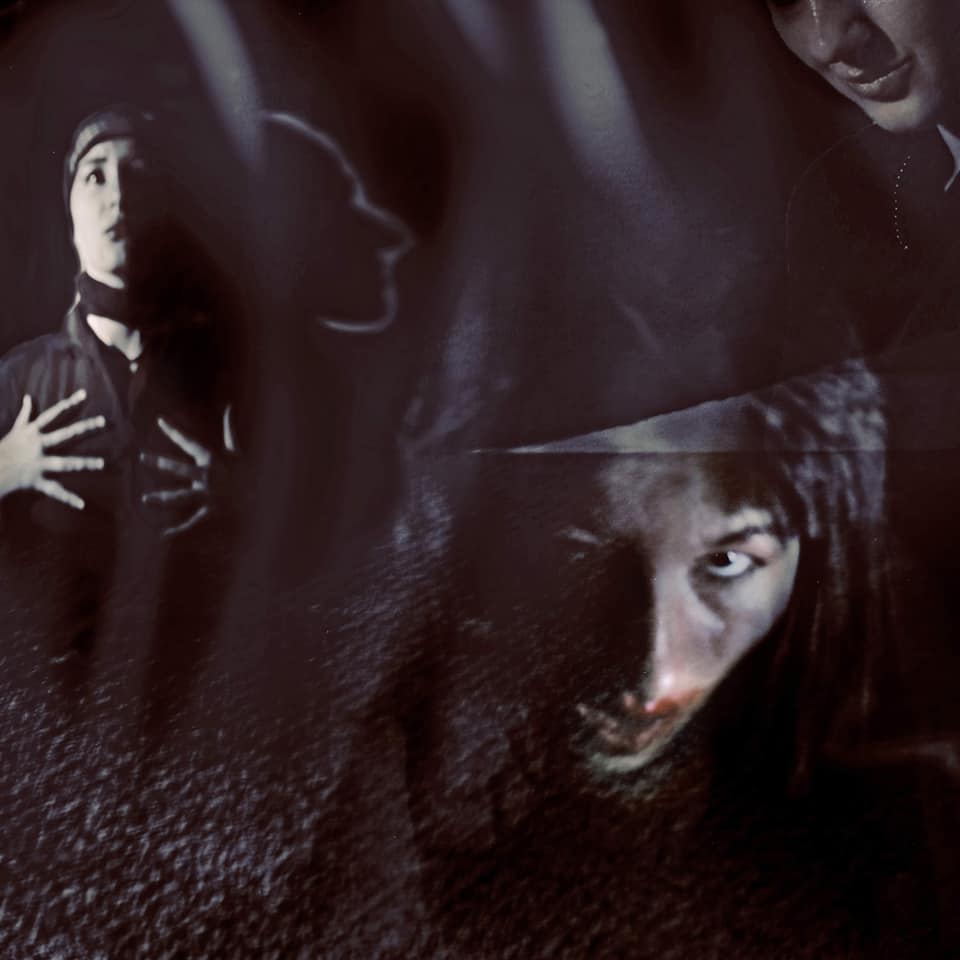
Self-portrait. Marianna Hlynska
In Ivano-Frankivsk, you created your own art space on Nyzova Street. What are its concept and purpose?
When I came back from the USA, I wanted to exhibit some of my art projects in Ivano-Frankivsk. At that time, I could not find a suitable place for that. There was still Khymera, but it lived out its last days. Bastion wasn’t suitable either. I had large chaotic collages—works from my solo show in America. I walked around, searched and at some point realized that there was no such place. I lived in an apartment on Nyzova Street.
One day while walking along the corridor, I thought: why look for another place? I can exhibit my works here.
Many people came to the opening, everything was different and I liked it. It was a one-day exhibition. To a certain extent, I was glad that Bastion refused to hold it because my corridor suited the exhibition perfectly. I told my friends that we could continue to use it. However, no one responded at that time.
What performances took place there?
When my parents bought me another apartment, I recalled the exhibition. Back then, the coronavirus pandemic started and we texted each other in our chat. It was the time when everyone was tired of staying at home. At some point, I wrote in the chat: “Let’s do something on Nyzova. A small art festival”.
Everyone wanted to attend an art event. We came up with the name Abracadabra. I first met the photographer Zoriana Kozak, and the model Yana Hetman came to Ivano-Frankivsk. Together we started inviting artists, tried to create the freest vibe possible. We decided to use everything: the attic, the yard. Many people responded. Everyone could come and occupy the desired space. We did a performance with Bohdana Komarnitska. The art at the festival varied, there was a spirit of freedom that I really liked.
We decided to use the space as an experimental platform and create projects that would be difficult to exhibit inside four walls. I had an idea to implement it as a group. Some people eventually refused, they had a different vision. So there were four of us: Zoriana Kozak, Serhii Glow, Yana Hetman and I. We organized The Nail exhibition. Young people joined us: such as Anton Borynets whom we engaged as a musician.

The Nail exhibition
We decided to do something completely new. At the exhibition Zebrus & Corpus, the exhibits were painted people. There was an entrance fee. Surprisingly, there were many people, everyone paid the fee. We introduced our own rules: one had to take off their shoes, because everything was covered, and hand over mobile phones. It was forbidden to take pictures. There were naked bodies, so we didn’t want to make it a mass event and have everything posted on Facebook right away. I think it would be impossible to exhibit naked painted people elsewhere. Moreover, we created a special vibe and gave candles to people. Glow made video projections, and special music played. For all of us, that exhibition was significant.
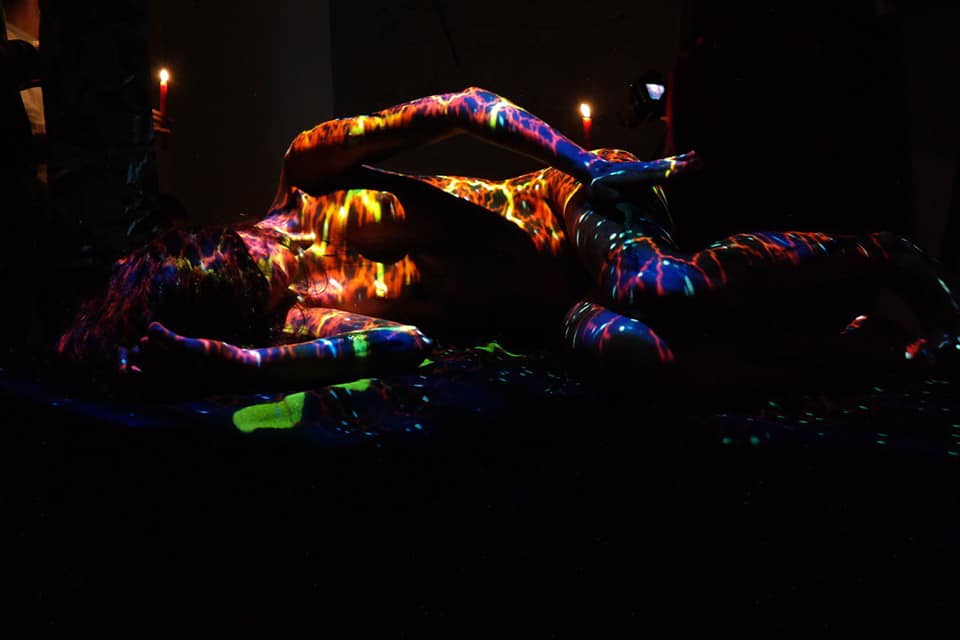
Zebrus & Corpus
Then we decided to organize Abracadabra-2, but on a larger scale. Our friends suggested implementing it in the village of Kolodiivka. We brought in visual art and DJs. We organized a leisure time, but with an art component. And then Abracadabra-3 was planned.
What happened to this art space now?
When the full-scale war started, I hosted people there. They recently left. The art space is currently on hold.
Which of the exhibitions is the most iconic for you?
Each exhibition was important. For example, In Search of Our Identity in Vagabundo. That was a series of self-portraits that I had been photographing for more than 10 years. Also, the art project Kolo with Yana Hetman and Serhii Glow, when we won a grant from the Warm City platform. Exhibitions on the Nyzova Street and in Kyiv; Abracadabra, where I started doing more performances with Bohdana Komarnitska.
There was full freedom in projects with artists, everyone wanted to do something completely different.
https://youtu.be/ZTSrd-pkLN4
In your opinion, what is the artistic environment of Ivano-Frankivsk like? Do you feel the difference between the generations?
When I started my creative career, of course, I was happy to find like-minded people. First, I joined the art NGO Forums. Then I met Mykola Dzychka, Yurii Bakai, Myroslava Kleban, Yuliia Sovtus and others. In the Columbus Photo Club, I met more people: Dmytro Petryna, Taras Dutka, Tetiana Pavlyk, and Rostyslav Kondrat. I have been always communicating with Anatolii Zvizhynskyi and Ihor Panchyshyn. Together with Zoriana Kozak, we went to the exhibition in Lutsk. Among the younger generation were Anton Borynets and Bohdana Komarnitska.
There is a difference in experience between generations, apparently. Older people have gone through a certain stage in their lives that young people are just going through, and that’s ok. The younger generation is more energetic and enthusiastic about doing something experimental and creative. They are always ready to pick up the baton. The older generation is ready to share their experiences, perhaps they are more skeptical about some things.
In Ivano-Frankivsk, there is a lack of funds to create everything the way one wants to. The older generation wants something more proper, in-depth, and mature. Unfortunately, it is simply impossible to organize such things without money. Young people are more likely to be engaged in low-budget projects. They want to experiment. I think that Ivano-Frankivsk can be a good platform for creativity and experimenting.
At first glance, it seems that there are more male than female artists in the Ivano-Frankivsk artistic environment. Does this influence the creative work of female artists?
I think that the situation with this is getting better. I remember coming to Forums, and there were just two or three girls and 20 guys. And when I came to the photo club, there were two girls and 17 guys.
When we got together, I wished there were more women. I always thought: why weren’t they there? Men confidently presented what they were doing, while women hesitated.
Now more and more women are declaring themselves. Many creative girls are serious about what they do. I think these are positive changes that are happening all over the world. It used to be hard for women to create. Even those who devoted their lives to creativity were forgotten. And now this is changing, this is a global trend.
I see many young people who are drawn to creativity, hold exhibitions, and more and more women become curators. It seems that they were not taken very seriously before. But when you hold exhibitions and stubbornly follow your own path, the opinion about you changes. Men regard women on an equal footing, as creative individuals. Although, I think, we still have a long way to go before everything becomes equal.
Sometimes it seemed that I was not taken seriously. However, I had a clear vision of who I was and what I was doing, and I knew for sure that I was on the right path and would continue to follow it. I filtered out what to accept and what not. When I was working as a photographer, a man asked me: “Why do you get into creativity? Go work as a teacher.” I can’t say that I was offended. In life, there are people who sincerely help you, and there are those who will say: “Why do you need this?”. Perhaps this is some kind of testing yourself. The question from outside to ask myself: do I turn around and go the other way, or do I keep going forward? I think that in any field, at some point, there comes external testing of yourself.
For me, gender issues don’t matter. There is an artist. There is no such thing as a female or male view, there is a creator’s view.
Is it hard to be an artist in Ivano-Frankivsk?
Sometimes it is hard and sometimes not. In Ukraine, even in Ivano-Frankivsk, there is still full freedom when you can turn your apartment into an art space. I don’t know where else it is possible. Ivano-Frankivsk has a creative spirit, movement, energy, interest, and new people are constantly appearing in it. However, there is also stewing in your own juice. Sometimes, everything becomes predictable. And sometimes it is hard to organize something, to find a common language with people. Also, it is hard to find financial support. In Germany, the government helps artists financially. This affects the quality of artworks. But we got grants from the Warm City platform that give us the opportunity to create.
This is a good platform for something more interesting to be born.
But from time to time one needs to leave Ivano-Frankivsk. Because when you sit in one place for a long time, you feel as if you are in a pot: you sit and stew. You have to leave any small city from time to time.
What is lacking in the contemporary art of Ivano-Frankivsk?
There is a lack of financial support and understanding from the authorities that art is important for the city.
There is conservatism. We are not in the Soviet Union and there is no need to hide anymore. It seems that Ivano-Frankivsk is somehow ignoring contemporary art. The same festivals are held, which seem outdated to some people.
Please tell us about your residency in Germany. What are you working on now?
I arrived in the village of Kirschau with Zoriana Kozak. The residency is located in the factory, part of which was transformed into an art space. There is a very large gallery consisting of two rooms. The residency hosts two persons during the three months. Every three or four months there is a rotation.

Marianna Hlynska and Zoriana Kozak
One of our tasks is to help in organizing the photo exhibition Beauty of Ukraine. Our curator Holger had visited Ivano-Frankivsk before, and we had joint projects. I invited Rostyslav Kondrat to help with the selection of photos. At the same time, there was the opening of the exhibition Fairy Tales And Myths. Also, photographers from the Columbus Club, participants of the exhibition Rostyslav Kondrat, Mykola Kalytchuk, and Tetiana Pavlyk came to us.
And we are also working on our own projects here. We use clay, photos and videos, experiment and reflect on current issues. If everything goes well, then in October we will exhibit works created here together with three Ukrainian artists. We will also participate in the Rich Soil exhibition, which will open in September.
The conceptual name of our own project is Fluid Identity. Here we touch on the current issues. We reflect on the topics of war, our feelings in a foreign environment, the process of adaptation, understanding/misunderstanding of language. We arrived in a village where everyone speaks German, and we don’t. The topic of fluid, flowing identity is quite relevant to me. One of the projects I plan to exhibit is my clothes which I was wearing when I came to Germany. It is completely painted with words. One of the T-shirts had the inscription “Don’t panic”. I will display my clothes together with the T-shirt I bought here. I also painted it. Also, I write in Ukrainian and English on white pillows.
A residency is an opportunity to do something spontaneously. I created several artworks on the subject of industrial nature. I work a lot with masks bringing them to different environments. This concept is about the way we try to adapt and adjust. Fluid Identity is also the answer to the question of where I came from and what I see here now.
Will you bring your artworks to Ukraine?
No, I won’t. They will remain in the gallery archive. We have printed a catalog containing all the artworks exhibited at the show. I don’t think it makes sense to exhibit them in Ukraine. The exhibition is aimed at foreigners who have not been to Ukraine that much, so it makes sense to do this abroad. Everyone is shocked by photos from the war. They are important for people to see what is really happening. Unfortunately, it wasn’t until now that they started talking about Ukraine. I don’t think the exhibition will be interesting for Ukrainians, the catalog is quite enough.
Does place influence creativity?
Yes, it influences in terms of reflections. You begin to think differently, to study society. Therefore, it is reflected in creativity. At the residency, we spend a lot of time in nature, so we want to take a lot of shots right there. I try to be open to where I am now, to explore myself, the place, and the people.
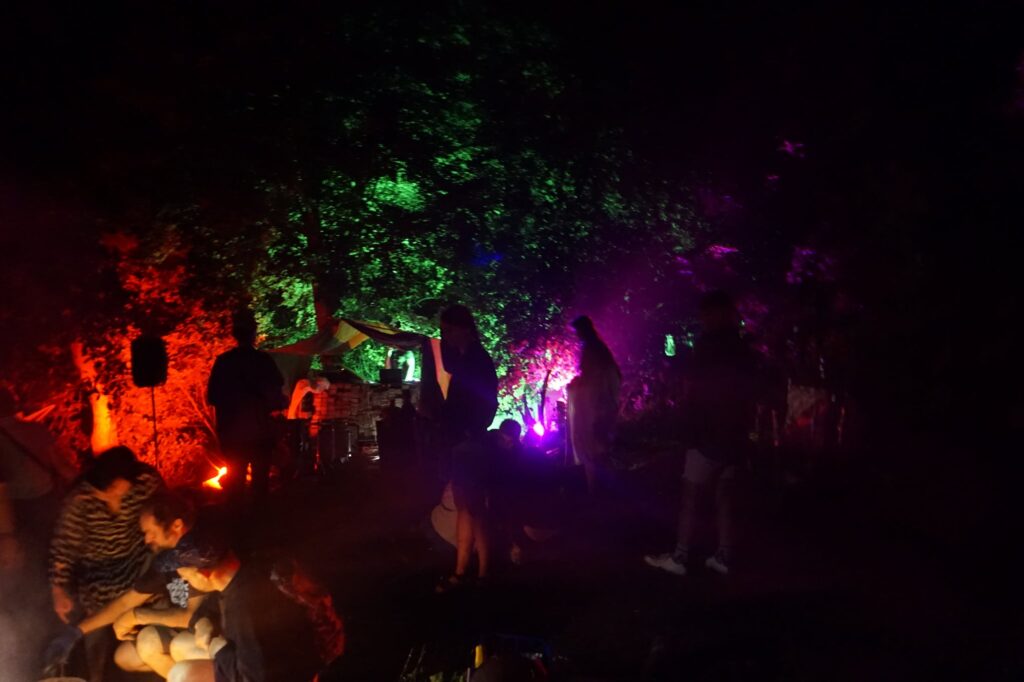
Abracadabra 2. Photo by Anatolii Zvizhynskyi
You said that for you the camera is one of the tools for exploring your identity. Is there a lot of personal in your work?
Yes, a lot. I created a series of self-portraits. I can’t say that I take pictures of myself for the sake of doing it. This is an exploration of myself as a person, an individual in a wider space: a space of interaction with others and society.
I’m interested in the topic of motives for actions, behavior, and the dark sides of a person. I studied psychology, so I use this. For me, the question is whether we can go beyond ourselves or not. How much of everything we perceive is ours or imposed? By photographing myself or my body, I become like an actor on the stage who conveys thoughts, changes, etc. to the audience.
Who is your audience?
It’s hard to describe. I met many different people who responded to my artworks and those who did not. My audience is people who are touched by the same topics as me: psychology, the study of emotions and interactions. Some people are interested in these topics, and some are not. This is normal.
How much did the war change you as an artist?
I think that it influenced human things and the revaluation of values in general. One can lose everything in a moment, for example, material things. The most important thing is just to stay alive.
It’s a cruel reminder, but a reminder of the value of the moment, the value of being around the beloved ones, and the value of helping each other.
These circumstances once again brought me back to the reflections that I had for a long time before: what motivates a person to commit evil and crimes? Is it a pathology, a deviation, or something inherent? Wars have occurred since time immemorial, they have never ended.
Why can’t we all live in peace together? How to solve this, what drives people? I started writing more. When you don’t know what to do, when all your friends are leaving, your anxiety and hesitation somehow pour out. This is a moment when reality cannot be ignored. Now words and expressions are important to me in my work.
Can art reflect on the war experience during the war or is a distance in time needed for that?
I think that it can even now. Over time, it will change, it will be different. Moments of anxiety, when you wake up from sirens, can’t sleep or buy medicine—this is a primary experience. It is important to reflect on this.
When it’s over, we’ll see the aftermath, and that’s a different experience. Some of my friends can’t draw right now. I understand them, they choose to put their creative work on hold because they can’t pull themselves together now. It depends on the person. If you feel an urge, you have an inner need, you want to leave something, you have to do it.
If we reflect on this experience, is it for ourselves or the western audience?
I don’t think that artists adjust to the western audience. Now it shows empathy for us. Everyone takes the war too close to the heart. Having survived World War II, Europe understands that it can happen to them again. They help in a human way, because they realize that their experience is secondary and that no one is safe. And in general, interest in Ukrainian culture has increased. I think it’s because of empathy. Our artists are doing what they have always done, it’s just that the war knocked everyone out of the rut, and they are reflecting.
What is the function of art during the war?
Art has historical value because it shows all the horror that is happening and what people are going through. It is probably necessary to do something so that this does not happen again. For example, one can record through artistic reflections what it is like to be in Ukraine at the moment. I think in 10 years they will be even more valuable.
I don’t think that art can change the world and that people will suddenly think, looking at the artpiece: “That’s it, let’s not shoot anymore.”
No, but it needs to be shown. For example, Picasso’s Guernica shows all the horror and we still look at it. We feel empathy, we understand what those people went through and how terrible it was, and we think about what we can do to avoid it. To some extent, the artpiece is a catalyst for dialogue, a reminder to the whole of the humanity of how evil the war is. An important function of art is to cover these events.
Photos are taken from the social media of the interviewee and the Nyzova Art Gallery

